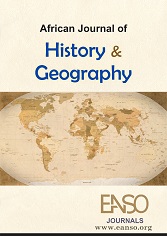An Inquiry into the Lived Experiences of Child Soldiers within the Lord's Resistance Army Insurgency in Amuru District, 1987-2024
الملخص
Focusing on the heavily impacted region of Amuru District, this research delved into the lived experiences of former child soldiers conscripted by the LRA from 1987 to 2024. The study’s specific objectives were to: (i) examine the recruitment and abduction strategies employed by the LRA in Amuru District, (ii) investigate the experiences encountered, and (iii) assess the psychological and social effects of these experiences on child soldiers. Based on a qualitative approach and phenomenological design, the study used in-depth interviews, participant observation and Focus Group Discussions to collect the required data. The LRA leaders used systematic indoctrination and forced recruitment, instilling fear and dismantling social structures. The experiences included forced participation in violent killings often against their own communities, inhuman punishments, physical abuse, starvation and constant threats of death. Despite demonstrating remarkable resilience, many former child soldiers continue to face significant obstacles, including social stigma and economic hardship. The Lord's Resistance Army (LRA) strategically abducted children, using violent tactics to ensure dependency. The group systematically dismantled their identities through abuse and ritualised violence, inflicting lasting psychological trauma and social stigma. After the conflict, these former child soldiers face a difficult reintegration, with their trauma fueling a cycle of violence and poverty that destabilises entire communities. A multi-pronged mental health approach for addressing the complex trauma experienced by former child soldiers. Combat social stigma and rejection through structured, community-wide sensitisation and reconciliation initiatives, develop accelerated learning programs to build foundational literacy and numeracy skills, and commission and fund longitudinal studies that track the well-being of survivors and their families over time.
التنزيلات
المراجع
Alava, H. (2022). Christianity, Politics and the Afterlives of War in Uganda.
Amone-P'Olak, K. (2004). A study of the psychological state of formerly abducted children at Gulu World Vision Trauma Centre. Torture: quarterly journal on rehabilitation of torture victims and prevention of torture, 14(1), 24-34.
Annan, J., Blattman, C., Mazurana, D., & Carlson, K. (2011). Civil war, reintegration, and gender in Northern Uganda. Journal of Conflict Resolution, 55(6), 877-908.
Avirgan, T., & Honey, M. (1982). War in Uganda: the legacy of Idi Amin. (No Title).
Bainomugisha, A. (2011). Child Soldiers in Northern Uganda: An Analysis of the Challenges and Opportunities for Reintegration and Rehabilitation (Doctoral dissertation, University of Bradford).
Blattman, C., & Annan, J. (2008). Child combatants in northern Uganda: Reintegration myths and realities. In Security and post-conflict reconstruction (pp. 123-145). Routledge.
Brown, M. A. (2020). Human rights and the borders of the human. Borderlands Journal, 19(1), 88-114.
Creswell, J. W., & Creswell, J. D. (2017). Research design: Qualitative, quantitative, and mixed methods approach. Sage Publications.
Doom, R., & Vlassenroot, K. (1995). Early warning and conflict prevention: Minerva's wisdom?. ABOS.
Doom, R., & Vlassenroot, K. (1999). Kony's message: a new koine? The Lord's Resistance Army in Northern Uganda. African affairs, 98(390), 5-36.
Ehrenreich, R. (1998). The stories we must tell: Ugandan children and the atrocities of the Lord's Resistance Army. Africa Today, 79-102.
Finnström, S. (2020). Living with bad surroundings: War, history, and everyday moments in northern Uganda. Duke University Press.
Lapwoch, G., & Amone-P’Olak, K. (2016). Social identity and conflict in Northern Uganda. Understanding Peace and Conflict Through Social Identity Theory: Contemporary Global Perspectives, 185-198.
Lennon, T., Kemal, S., Heffernan, M. E., Bendelow, A., Sheehan, K., Davis, M. M., & Macy, M. L. (2024). Childhood exposure to firearm violence in Chicago and its impact on mental health. Academic Pediatrics, 24(6), 982-986.
Mamdani, M. (1996). Reconciliation without justice. Southern African Review of Books, 46(3).
Olema, D. K., Catani, C., Ertl, V., Saile, R., & Neuner, F. (2014). The hidden effects of child maltreatment in a war region: Correlates of psychopathology in two generations living in Northern Uganda. Journal of Traumatic Stress, 27(1), 35-41.
Pavelich, K. (2013). Gender Biases and Armed Conflict: Assessing the Reintegration Experience of Women from the LRA.
Peel, K. D. (2015). Abduction, Rebellion and Reprieve: The Narratives of Former Members of the Lord's Resistance Army.
Pham, P. N., Vinck, P., & Stover, E. (2008). The Lord's Resistance Army and forced conscription in northern Uganda. Human Rights Quarterly, 30(2), 404-411.
Silva, J. R. (2007). Child Soldiers: A Call to the International Community to Protect Children From War. Suffolk Transnat'l L. Rev., 31, 681.
Singer, P. W. (2006). Children at war. Univ of California Press.
Smith, B. (2022). A History of Military Morals: Killing the Innocent (Vol. 138). Brill.
Van Acker, F. (2004). Uganda and the Lord’s Resistance Army: The new order no one ordered. African Affairs, 103(412), 335-357.
Wessells, M. (2006). Child soldiers: From violence to protection. Harvard University Press.
الحقوق الفكرية (c) 2025 Patrick Ochen, Odong James Bosco, Simon Okello, Agatha Alidri

هذا العمل مرخص حسب الرخصة Creative Commons Attribution 4.0 International License.




























